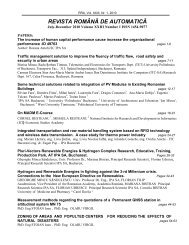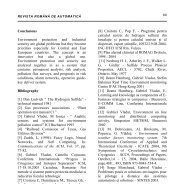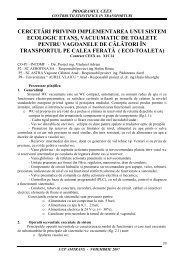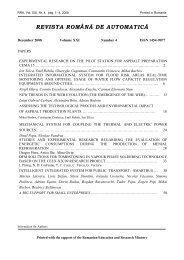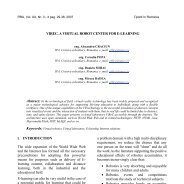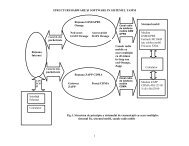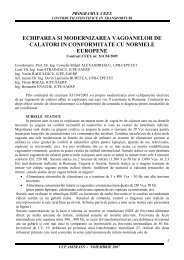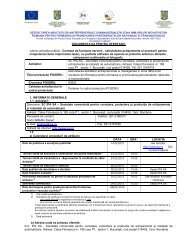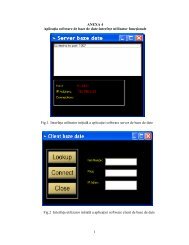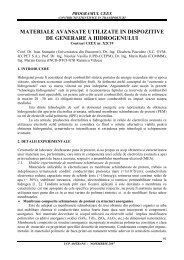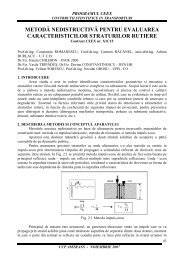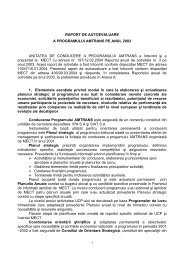Part I - IPA SA
Part I - IPA SA
Part I - IPA SA
You also want an ePaper? Increase the reach of your titles
YUMPU automatically turns print PDFs into web optimized ePapers that Google loves.
REVISTA ROMÂN DE AUTOMATIC<br />
13<br />
system of the parameter monitoring system,<br />
by selecting some methods adequate and<br />
applicable to the technological processes<br />
within the tritium removal plants.<br />
The route we shall pursue for achieving the<br />
proposed goal is to, primarily, based on the<br />
experience accumulated until the present,<br />
develop a high-performance system specific<br />
to a certain type of tritium removal plant, and<br />
to continue with the expansion of the<br />
system’s possibilities and applicability for a<br />
broad range of plants, but especially for those<br />
used in the nuclear power plants.<br />
The control software, with the relevant<br />
controlling loops and transfer functions are<br />
made with the help of the monitoring<br />
program packages, and contained command,<br />
acquisition, control sub-modules and the data<br />
saving module in files containing the process<br />
data needed later, to set up the data base and<br />
the process analysis software.<br />
The scanning of the measurements points on<br />
the plant are made with Field Point modules<br />
and through the optimization of the<br />
monitoring system the process simulation<br />
system in case of emergency will be set up;<br />
his system plays an important part in fighting<br />
the natural disasters and industrial accidents.<br />
The system also includes the control graphic<br />
part, which includes all the components<br />
monitored and surveyed during process, on-line.<br />
Mainly, the process simulation is monitored<br />
in the tritium removal units, where the<br />
isotopic exchange reaction and the separation<br />
factor will be defined, as well as the basic<br />
equations of isotope separation.<br />
A new element in this simulation system is the<br />
introduction into the automation system of a<br />
simulation part in which the main elements in<br />
the process will be monitored, in order to<br />
optimize their functioning in case some faults<br />
appear, and to identify faulty field elements.<br />
Due to the software’s universality, the<br />
program can be adapted, depending on the<br />
process requested by any industrial user,<br />
especially to the technological plants with a<br />
high degree of damage and accident.<br />
In order to lower the technological failure<br />
risk, for the first time in the country an<br />
optimisation algorithm of the monitoring<br />
system by prediction will be established,<br />
using the gradient function and the process<br />
analysis with data base.<br />
For monitoring the cryogenic distillation's<br />
installation is necessary to control the<br />
temperature very carefully. For that we made<br />
an automation system with data acquisition<br />
and control which provide all data for analyze<br />
and for simulating the temperature of the<br />
process.<br />
The control is achieved using an array of<br />
sensors and controllers. The sensors used for<br />
monitoring the process are type J<br />
thermocouples, RTD and with platinum. The<br />
control system uses different sensors of the<br />
same type but better quality. The temperature<br />
control is achieved by controlling the<br />
electrical power fed to the heaters. Besides<br />
sensing the fluid temperatures at various<br />
points, we also monitor the vapor pressure<br />
and the heavy water level in the isotopic<br />
exchange column, an important module for<br />
tritium removal.<br />
We used the various DSC (Datalogging and<br />
Supervisory Control) module tools to easily<br />
configure, view, and acknowledge alarms and<br />
events. An alarm is a specific type of event<br />
related to the value of a tag. Events can be tag<br />
events, such as a change in Alarm State, or<br />
system events, such as a user login or Tag<br />
Engine launch.<br />
The simulation and optimization method<br />
includes the analysis of control systems that<br />
explains functionally the behaviour of a<br />
combination of a temperature-sensitive mass.<br />
Also, the structure and environment in which<br />
exists, the various disturbances to which the<br />
mass and the structure are subjected, and the<br />
physical and electrical arrangements of the<br />
thermal and electronic elements used to<br />
regulate the temperature of the mass.<br />
The system error or system deviation<br />
describes the accuracy and stability of control<br />
and is the ultimate criterion for evaluating the<br />
performance of the temperature control



